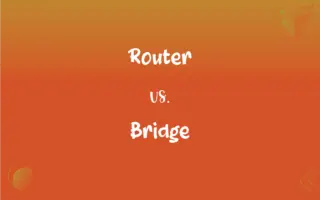Java 7 vs. Java 8: What's the Difference?
Edited by Aimie Carlson || By Janet White || Published on February 7, 2024
Java 7 introduced new features like the try-with-resources statement, while Java 8 brought major changes like lambda expressions and the Stream API for functional-style programming.

Key Differences
Java 7, released in July 2011, focused on improving the language and JVM with features like the Fork/Join framework and the try-with-resources statement. Java 8, released in March 2014, represented a significant shift in the language, introducing lambda expressions, the Stream API, and functional interfaces, which facilitated a more functional programming approach.
In Java 7, enhancements included the diamond operator for type inference in generic instances, simplified varargs method invocation, and improved exception handling. Java 8 further advanced the language by introducing lambda expressions, which allowed for clearer and more concise code, especially in functional-style operations.
Java 7 introduced new APIs like the Path API for file system operations and a new concurrency library with the Fork/Join framework. Java 8, on the other hand, introduced a comprehensive date and time API (java.time), the Stream API for processing collections of data in a functional style, and new default methods in interfaces.
Java 7 brought minor performance improvements and enhancements to the garbage collector, while Java 8 focused on optimizing the performance of lambdas and streams, alongside improvements in the Nashorn JavaScript engine.
Java 7 set the stage for cleaner, more robust code with its features, but Java 8's introduction of functional programming concepts marked a paradigm shift, influencing how developers write and think about Java code.
ADVERTISEMENT
Comparison Chart
Release Date
July 2011
March 2014
Key Features
Try-with-resources, Fork/Join framework, diamond operator
Lambda expressions, Stream API, new date/time API
Programming Paradigm
Improved OOP features
Introduction of functional programming
API Enhancements
New file system API (NIO.2)
New date and time API, enhancements to Collections API
Performance
Minor improvements, GC enhancements
Optimizations for lambda and streams, Nashorn JavaScript engine
ADVERTISEMENT
Java 7 and Java 8 Definitions
Java 7
Java 7 enhanced exception handling with multi-catch blocks, simplifying error management.
Multi-catch blocks in Java 7 streamlined my exception handling code.
Java 8
Java 8 is a major update to Java, introducing lambda expressions for functional programming.
Lambda expressions in Java 8 made my code more concise and readable.
Java 7
Java 7 marked a significant update to the Java programming language with various improvements.
Java 7's enhancements greatly improved the robustness of my Java applications.
Java 8
Java 8 added default methods in interfaces, allowing more flexible interface evolution.
Default methods in Java 8 interfaces helped me maintain backward compatibility with ease.
Java 7
Java 7 introduced the Fork/Join framework, improving performance in parallel processing.
I used the Fork/Join framework in Java 7 for efficient parallel computation.
Java 8
Java 8 brought the Stream API, enabling more efficient operations on collections.
With Java 8's Stream API, I could manipulate collections with less code.
Java 7
Java 7 is a version of the Java programming language that introduced the try-with-resources statement for better resource management.
Java 7 allowed me to simplify my code with the try-with-resources statement.
Java 8
Java 8 introduced a new date and time API for improved date handling.
The new date and time API in Java 8 simplified my date calculations significantly.
Java 7
Java 7 included new features like the diamond operator to infer type parameters in generic instance creation.
The diamond operator in Java 7 made my generic instances much cleaner.
Java 8
Java 8 optimized performance with enhancements in the Nashorn JavaScript engine and lambda execution.
Performance improvements in Java 8, especially with lambda expressions, boosted my application's efficiency.
FAQs
What are lambda expressions in Java 8?
Lambda expressions in Java 8 are a feature that allows concise representation of methods using an arrow syntax.
Did Java 7 improve exception handling?
Yes, Java 7 introduced multi-catch blocks, simplifying exception handling.
What is the Stream API in Java 8?
The Stream API in Java 8 enables functional-style operations on streams of elements, such as collections.
What is the Fork/Join framework in Java 7?
The Fork/Join framework in Java 7 is designed for parallel execution of tasks.
Was garbage collection improved in Java 7?
Yes, Java 7 made minor improvements in garbage collection and performance.
What major feature was introduced in Java 7?
Java 7 introduced the try-with-resources statement for automatic resource management.
How did Java 7 enhance file handling?
Java 7 introduced the NIO.2 (New I/O 2) file API for more efficient file handling.
What is the diamond operator in Java 7?
The diamond operator in Java 7 simplifies the syntax when creating instances of generic classes.
Does Java 8 support functional programming?
Yes, Java 8 supports functional programming, particularly with lambda expressions and the Stream API.
Can interfaces have methods with implementation in Java 8?
Yes, Java 8 allows interfaces to have default and static methods with implementations.
What was the impact of Java 7 on Java's development?
Java 7 set the stage for further enhancements, adding features that improved coding efficiency and performance.
How does Java 8 handle JavaScript execution?
Java 8 introduced the Nashorn JavaScript engine for improved JavaScript execution.
What is the significance of default methods in Java 8?
Default methods in Java 8 allow adding new methods to interfaces without breaking existing implementations.
How did Java 8 improve date and time handling?
Java 8 introduced a new date and time API (java.time) for more intuitive and flexible date and time handling.
What performance enhancements are seen in Java 8?
Java 8 brought performance enhancements in lambda and stream processing, as well as in the Nashorn engine.
How did Java 7 influence Java programming practices?
Java 7's features like try-with-resources and NIO.2 influenced more efficient and cleaner Java programming practices.
How did Java 8 change the approach to Java development?
Java 8 introduced functional programming concepts, changing the way developers approach Java development with more emphasis on concise and expressive coding.
How is multi-threading affected in Java 7?
Java 7's Fork/Join framework optimizes and simplifies the use of multi-threading.
What are functional interfaces in Java 8?
Functional interfaces in Java 8 are interfaces with exactly one abstract method, used as lambda expressions' target types.
What are type inference improvements in Java 7?
Type inference was improved in Java 7 with the diamond operator, reducing verbosity in code.
About Author
Written by
Janet WhiteJanet White has been an esteemed writer and blogger for Difference Wiki. Holding a Master's degree in Science and Medical Journalism from the prestigious Boston University, she has consistently demonstrated her expertise and passion for her field. When she's not immersed in her work, Janet relishes her time exercising, delving into a good book, and cherishing moments with friends and family.
Edited by
Aimie CarlsonAimie Carlson, holding a master's degree in English literature, is a fervent English language enthusiast. She lends her writing talents to Difference Wiki, a prominent website that specializes in comparisons, offering readers insightful analyses that both captivate and inform.































































